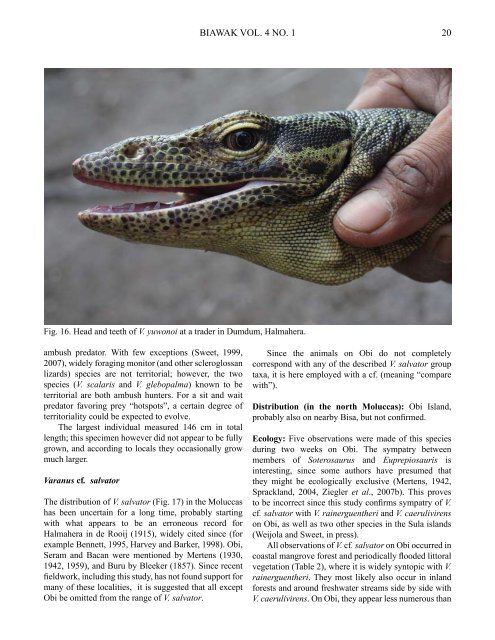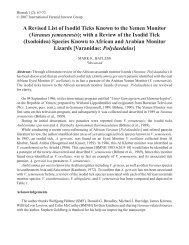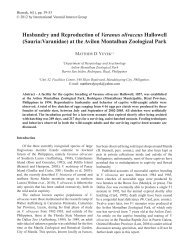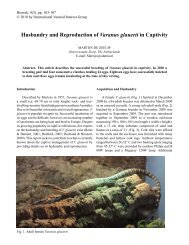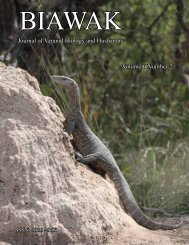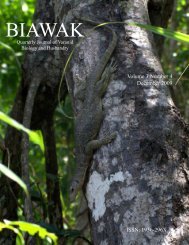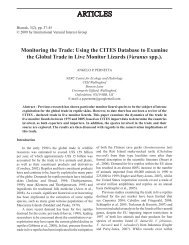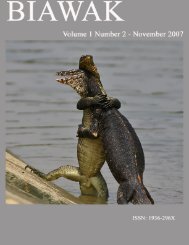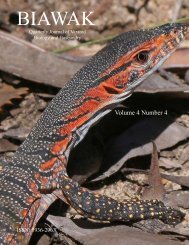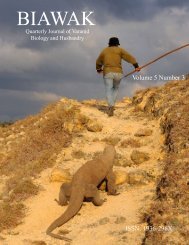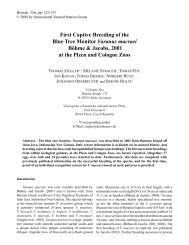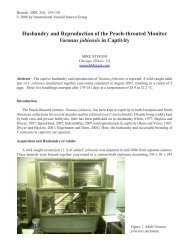Vol. 4 No. 1 - International Varanid Interest Group
Vol. 4 No. 1 - International Varanid Interest Group
Vol. 4 No. 1 - International Varanid Interest Group
You also want an ePaper? Increase the reach of your titles
YUMPU automatically turns print PDFs into web optimized ePapers that Google loves.
Fig. 16. Head and teeth of V. yuwonoi at a trader in Dumdum, Halmahera.<br />
ambush predator. With few exceptions (Sweet, 1999,<br />
2007), widely foraging monitor (and other scleroglossan<br />
lizards) species are not territorial; however, the two<br />
species (V. scalaris and V. glebopalma) known to be<br />
territorial are both ambush hunters. For a sit and wait<br />
predator favoring prey “hotspots”, a certain degree of<br />
territoriality could be expected to evolve.<br />
The largest individual measured 146 cm in total<br />
length; this specimen however did not appear to be fully<br />
grown, and according to locals they occasionally grow<br />
much larger.<br />
Varanus cf. salvator<br />
The distribution of V. salvator (Fig. 17) in the Moluccas<br />
has been uncertain for a long time, probably starting<br />
with what appears to be an erroneous record for<br />
Halmahera in de Rooij (1915), widely cited since (for<br />
example Bennett, 1995, Harvey and Barker, 1998). Obi,<br />
Seram and Bacan were mentioned by Mertens (1930,<br />
1942, 1959), and Buru by Bleeker (1857). Since recent<br />
fieldwork, including this study, has not found support for<br />
many of these localities, it is suggested that all except<br />
Obi be omitted from the range of V. salvator.<br />
BIAWAK VOL. 4 NO. 1<br />
Since the animals on Obi do not completely<br />
correspond with any of the described V. salvator group<br />
taxa, it is here employed with a cf. (meaning “compare<br />
with”).<br />
distribution (in the north Moluccas): Obi Island,<br />
probably also on nearby Bisa, but not confirmed.<br />
ecology: Five observations were made of this species<br />
during two weeks on Obi. The sympatry between<br />
members of Soterosaurus and Euprepiosauris is<br />
interesting, since some authors have presumed that<br />
they might be ecologically exclusive (Mertens, 1942,<br />
Sprackland, 2004, Ziegler et al., 2007b). This proves<br />
to be incorrect since this study confirms sympatry of V.<br />
cf. salvator with V. rainerguentheri and V. caerulivirens<br />
on Obi, as well as two other species in the Sula islands<br />
(Weijola and Sweet, in press).<br />
All observations of V. cf. salvator on Obi occurred in<br />
coastal mangrove forest and periodically flooded littoral<br />
vegetation (Table 2), where it is widely syntopic with V.<br />
rainerguentheri. They most likely also occur in inland<br />
forests and around freshwater streams side by side with<br />
V. caerulivirens. On Obi, they appear less numerous than<br />
20


